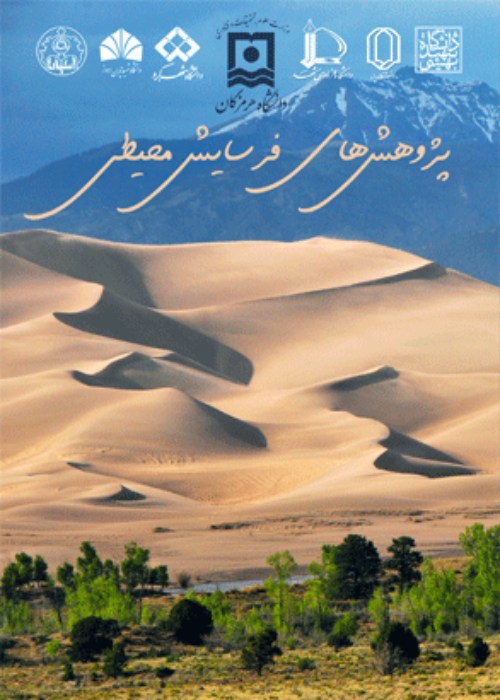Flood Inundation Mapping Using HAND (A Case Study of Kashkan River, Western Iran)
Floods pose significant risks as natural disasters on a global scale. In addition to climate change, anthropogenic activities have exacerbated the damaging effects of flooding over the past decade. Findings indicate that over 91 billion hectares of land in Iran are susceptible to flooding. Extensive hydrologic records reveal a total of 467 flooding events in the country up until 2002, contributing to a loss of 630 lives between 1982 and 1992. These alarming statistics underscore the necessity of studying and analyzing floods, as well as mapping inundation areas, in order to mitigate potential damage associated with future flooding events. One particular region in western Iran that has been heavily affected by recurring floods is the Kashkan River. This river traverses numerous urban and rural areas that are prone to annual flooding. Although various methodologies exist to investigate floods and identify areas susceptible to inundation, many of these approaches require data that may not be readily accessible. Consequently, this study employs the Height Above the Nearest Drainage (HAND) model to examine the flood-prone sections along the Kashkan River. Unlike other methods, the HAND model solely relies on a Digital Elevation Model (DEM), making it a promising and accurate technique for mapping inundation areas. By utilizing the HAND model, this research aims to identify specific sections of the Kashkan River that are prone to flooding. The findings of this study will contribute to a better understanding of flood dynamics in the region, enabling the development of effective strategies to minimize potential damage.
In order to examine the areas that are prone to flooding, we employed the Height Above Nearest Drainage (HAND) model. This model was originally introduced by Rennó et al. (2008) and operates by utilizing a Digital Elevation Model (DEM) to compute the distance between a grid-cell within the topography data and the nearest cell along the stream it drains into. By considering cells with HAND values below a specific threshold as inundated, we can identify areas that are susceptible to flooding. Notably, the HAND model offers the advantage of being raster-based, eliminating the need for the construction of cross-sections, which is a requirement for alternative techniques like HEC-RAS. For our investigation, we employed the Shuttle Radar Topography Mission (SRTM) DEM, which possesses a resolution of 30 meters. To validate the findings obtained from the HAND model, we employed flood maps generated from Sentinel-1 Synthetic Aperture Radar (SAR) data from March 2019. These flood maps were created using the Sentinel Application Platform (SNAP) software and the OTSU thresholding method. This method allows us to distinguish flooded areas within the study region and validate the results obtained from the HAND model.
The findings from this study indicate that a significant portion of the study area, encompassing 54.49 square km, is classified as highly flood prone. Additionally, an area measuring 31.78 square km is categorized as flood prone. Based on the HAND maps, it is evident that more than 30 percent of the study area is susceptible to flooding with varying intensities. The outcomes further reveal that the majority of both rural and urban regions situated alongside the Kashkan River are located within highly flood prone sections. Moreover, a comparison between the flood maps derived from Synthetic Aperture Radar (SAR) and the HAND results demonstrates that the HAND model successfully identified and classified the flood area in March 2019 as highly flood prone and flood prone. By examining the cross-section along the river, it becomes apparent that the inner banks of meanders are more susceptible to flooding when compared to the outer banks. Cross-section 1 analysis revealed that the sections with a high susceptibility to flooding are situated at higher elevations when compared to the maximum flood level observed in March 2019. This implies that in the event of more sever floods in the future, a larger portion of the areas along cross-section 1 will likely to be inundated. Additionally, the analysis demonstrated that during elevated flood flows, the outer bank of the meander is more prone to flooding compared to the inner bank. Similarly, in cross-section 2, the outer bank of the meander exhibits a greater extent of highly flood-prone areas compared to the inner bank. Furthermore, cross-section 2 findings indicate that the flood flow during March 2019 did not reach the upper limit of the highly flood-prone category. In contrast to the previous cross-sections, cross-sections 3 and 4 primarily experienced flooding along the inner bank of the meanders, and the HAND model also classified them as highly flood prone. These results suggest that the distribution of inundation in the Kashkan river is predominantly influenced by the underlying topography.
The findings indicated that both rural and urban regions situated along the Kashkan river exhibit a high vulnerability to flooding, with a propensity for inundation during flooding events. The results revealed the efficacy of the HAND model in accurately identifying the flood-prone segments of the Kashkan River. Analysis of cross-sections along the river revealed that the inundation patterns in mountainous meandering rivers are predominantly influenced by the underlying topography. Overall, the HAND model represents a swift and precise approach for delineating areas at risk of flooding, thereby assisting authorities in enhancing planning strategies and implementing effective measures for mitigating damages.
Flood , HAND model , Kashkan , Flood-prone , Inundation
- حق عضویت دریافتی صرف حمایت از نشریات عضو و نگهداری، تکمیل و توسعه مگیران میشود.
- پرداخت حق اشتراک و دانلود مقالات اجازه بازنشر آن در سایر رسانههای چاپی و دیجیتال را به کاربر نمیدهد.




